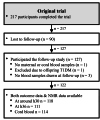Maternal and umbilical cord serum lipids in gestational diabetes predict offspring insulin secretion and resistance at the age of nine years
- PMID: 40544417
- PMCID: PMC12183131
- DOI: 10.1007/s11306-025-02281-9
Maternal and umbilical cord serum lipids in gestational diabetes predict offspring insulin secretion and resistance at the age of nine years
Abstract
Introduction: Maternal metabolism in pregnancy is a major determinant of intrauterine milieu and is assumed to have long-term consequences in the offspring.
Objectives: To study whether maternal or cord serum lipids are related to measures of insulin resistance and β-cell function in childhood.
Methods: This is a secondary analysis of a previous trial in which women with newly diagnosed gestational diabetes were randomized to metformin versus insulin treatment. Maternal serum lipids were measured during pregnancy and umbilical cord serum lipids at delivery. Offspring insulin resistance and β-cell function were assessed at nine years of age using serum insulin, C-peptide, and glucose concentrations measured during an oral glucose tolerance test. A total of 122 mother-child dyads were included in the analyses.
Results: After adjusting for multiple comparisons, higher cord serum docosahexaenoic acid, linoleic acid, and the ratio of linoleic acid to total fatty acids were significantly related to lower indices of β-cell function in childhood. In interaction models, cord serum linoleic acid was inversely related to offspring HOMA2-IR and measures of β-cell function only in the participants treated with insulin in pregnancy. Associations between maternal lipids and outcomes were not significant after Bonferroni adjustment.
Conclusion: Cord serum lipids, and potentially maternal lipids, are related to childhood insulin function. These findings highlight the importance of maternal lipid metabolism in pregnancies affected by gestational diabetes. Given the observed differences between metformin and insulin treatment groups, the feto-placental effects of prenatal metformin exposure should be further investigated.
Trial registration number: NCT02417090 at ClinicalTrials.gov, registered April 14th 2015.
Trial registration: This is secondary analysis of a previous study registered at ClinicalTrialg.gov (NCT02417090) on April 14th 2015.
Keywords: Gestational diabetes; Insulin resistance; Insulin secretion; Lipidomics; Metabolomics; Metformin.
© 2025. The Author(s).
Conflict of interest statement
Declarations. Competing interests: The authors declare no competing interests. Ethical approval: The study was approved by the ethics committee of the Hospital District of Southwest Finland (ETMK 31/2015) on April 27, 2015, and the study participants, signed an informed consent. The researchers informed mothers who discussed with their children about the study. The children also read the age-appropriate research bulletin and signed their own consent. Software availability: All analyses were carried out using readily available open-source software.
Figures



References
-
- Ahola-Olli, A. V., Mustelin, L., Kalimeri, M., Kettunen, J., Jokelainen, J., Auvinen, J., et al. (2019). Circulating metabolites and the risk of type 2 diabetes: A prospective study of 11,896 young adults from four Finnish cohorts. Diabetologia, 62(12), 2298–2309. 10.1007/s00125-019-05001-w - PMC - PubMed
-
- Cummings, S. W., Hatley, W., Simpson, E. R., & Ohashi, M. (1982). The binding of high and low density lipoproteins to human placental membrane fractions. Journal of Clinical Endocrinology and Metabolism, 54(5), 903–908. 10.1210/jcem-54-5-903 - PubMed
Publication types
MeSH terms
Substances
Associated data
LinkOut - more resources
Full Text Sources
Medical
Miscellaneous
